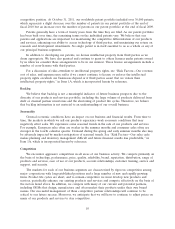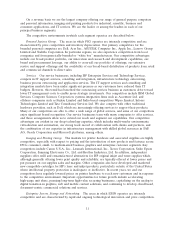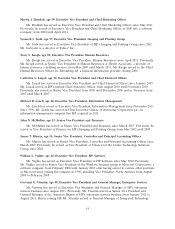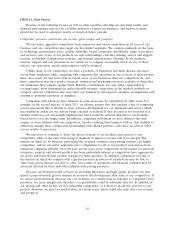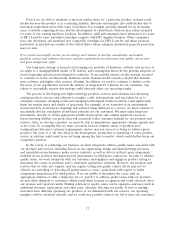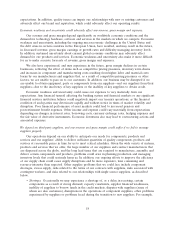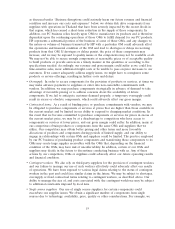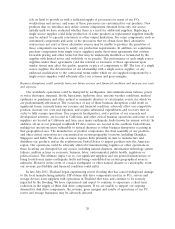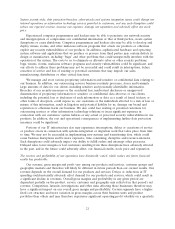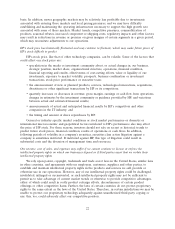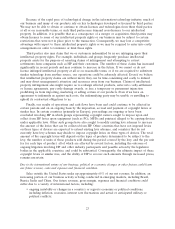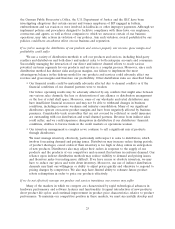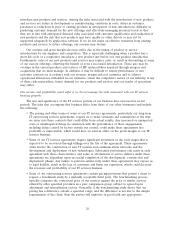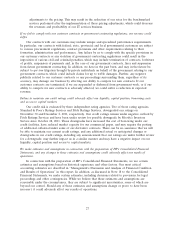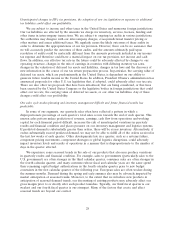HP 2011 Annual Report Download - page 26
Download and view the complete annual report
Please find page 26 of the 2011 HP annual report below. You can navigate through the pages in the report by either clicking on the pages listed below, or by using the keyword search tool below to find specific information within the annual report.expectations. In addition, quality issues can impair our relationships with new or existing customers and
adversely affect our brand and reputation, which could adversely affect our operating results.
Economic weakness and uncertainty could adversely affect our revenue, gross margin and expenses.
Our revenue and gross margin depend significantly on worldwide economic conditions and the
demand for technology hardware, software and services in the markets in which we compete. Economic
weakness and uncertainty, including the ongoing macroeconomic challenges in the United States and
the debt crisis in certain countries in the European Union, have resulted, and may result in the future,
in decreased revenue, gross margin, earnings or growth rates and difficulty managing inventory levels.
In addition, sustained uncertainty about current global economic conditions may adversely affect
demand for our products and services. Economic weakness and uncertainty also make it more difficult
for us to make accurate forecasts of revenue, gross margin and expenses.
We also have experienced, and may experience in the future, gross margin declines in certain
businesses, reflecting the effect of items such as competitive pricing pressures, inventory write-downs
and increases in component and manufacturing costs resulting from higher labor and material costs
borne by our manufacturers and suppliers that, as a result of competitive pricing pressures or other
factors, we are unable to pass on to our customers. In addition, our business may be disrupted if we
are unable to obtain equipment, parts or components from our suppliers—and our suppliers from their
suppliers—due to the insolvency of key suppliers or the inability of key suppliers to obtain credit.
Economic weakness and uncertainty could cause our expenses to vary materially from our
expectations. Any financial turmoil affecting the banking system and financial markets or any significant
financial services institution failures could negatively impact our treasury operations, as the financial
condition of such parties may deteriorate rapidly and without notice in times of market volatility and
disruption. Poor financial performance of asset markets could lead to increased pension and
post-retirement benefit expenses. Other income and expense could vary materially from expectations
depending on changes in interest rates, borrowing costs, currency exchange rates, hedging expenses and
the fair value of derivative instruments. Economic downturns also may lead to restructuring actions and
associated expenses.
We depend on third-party suppliers, and our revenue and gross margin could suffer if we fail to manage
suppliers properly.
Our operations depend on our ability to anticipate our needs for components, products and
services and our suppliers’ ability to deliver sufficient quantities of quality components, products and
services at reasonable prices in time for us to meet critical schedules. Given the wide variety of systems,
products and services that we offer, the large number of our suppliers and contract manufacturers that
are dispersed across the globe, and the long lead times that are required to manufacture, assemble and
deliver certain components and products, problems could arise in planning production and managing
inventory levels that could seriously harm us. In addition, our ongoing efforts to improve the efficiency
of our supply chain could cause supply disruptions and be more expensive, time consuming and
resource-intensive than expected. Other supplier problems that we could face include component
shortages, excess supply, risks related to the terms of our contracts with suppliers, risks associated with
contingent workers, and risks related to our relationships with single source suppliers, as described
below.
•Shortages. Occasionally we may experience a shortage of, or a delay in receiving, certain
components as a result of strong demand, capacity constraints, supplier financial weaknesses,
inability of suppliers to borrow funds in the credit markets, disputes with suppliers (some of
whom are also customers), disruptions in the operations of component suppliers, other problems
experienced by suppliers or problems faced during the transition to new suppliers. For example,
18




